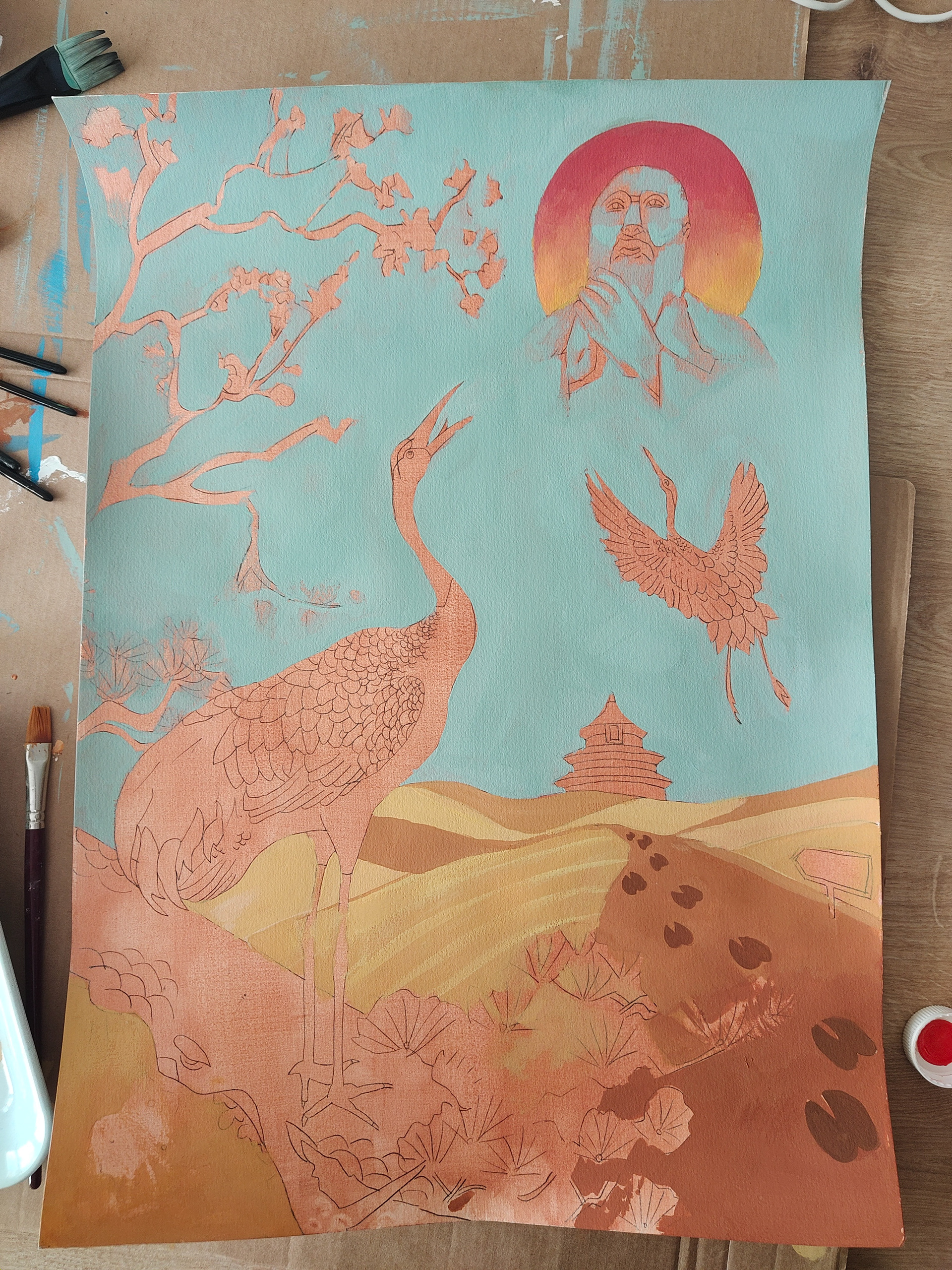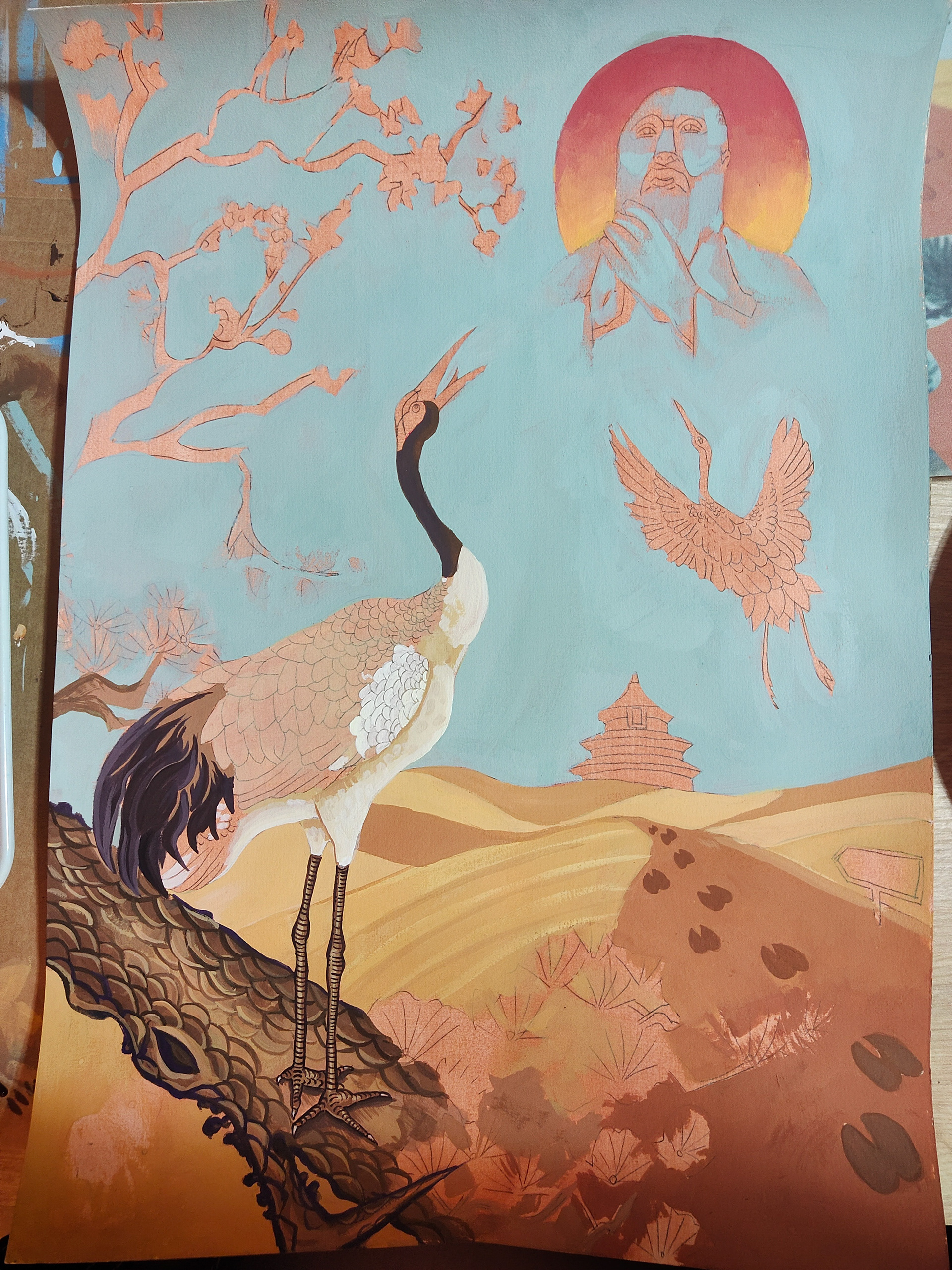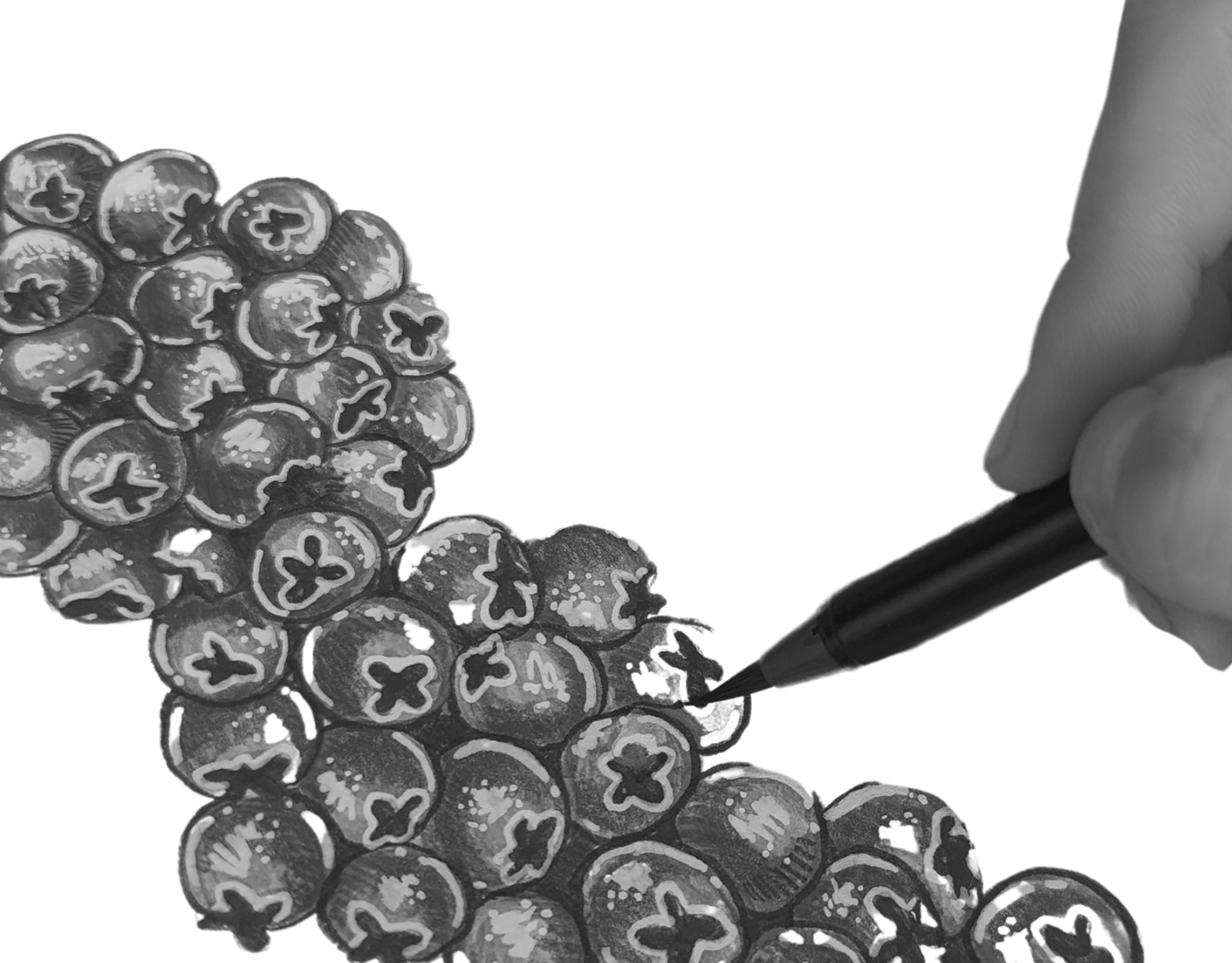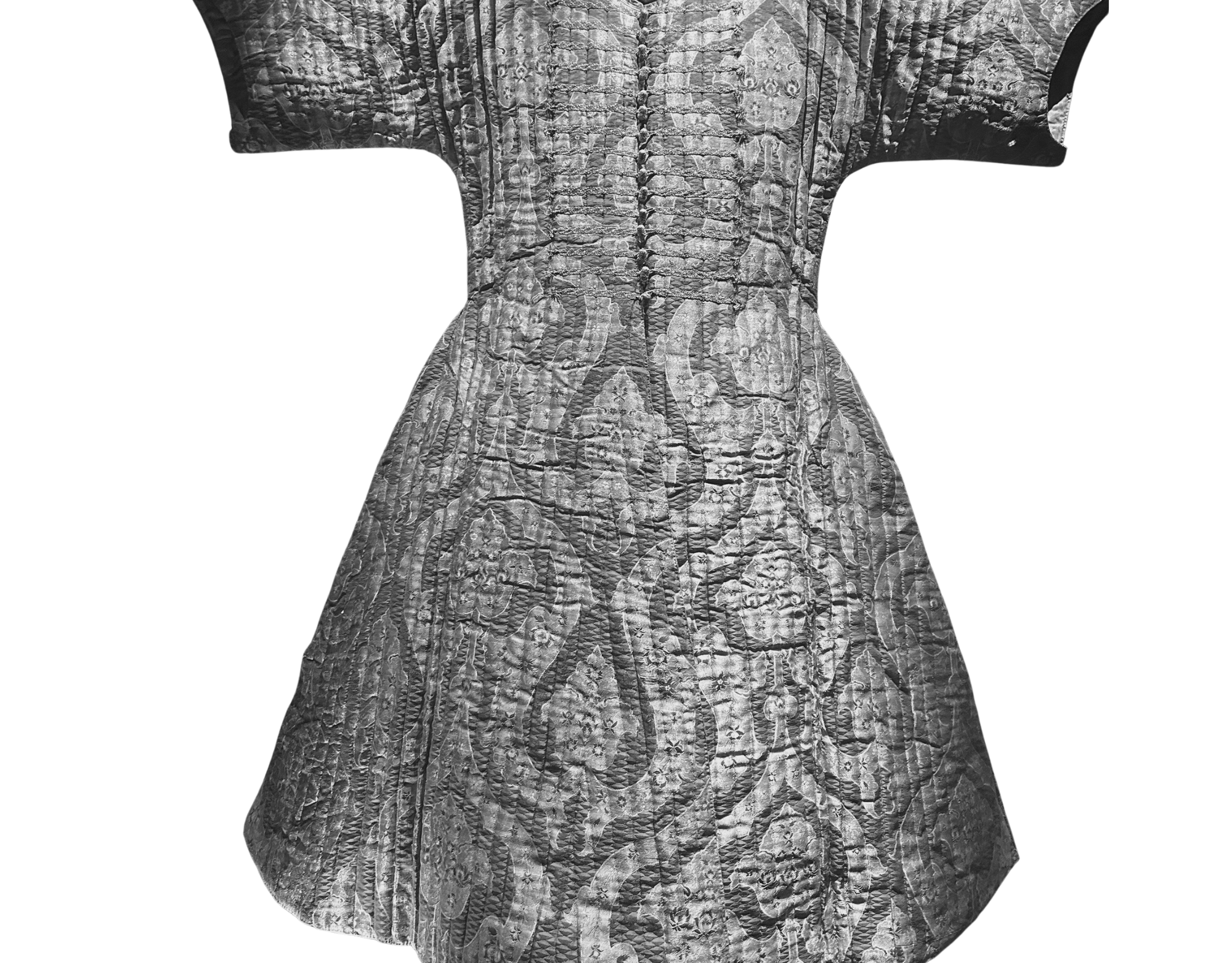Silk Road
In this artwork, I used gouache paint and drew inspiration from traditional Chinese watercolor, adding my own twist. Developing the concept for the final piece was a thoughtful process. The meaning of the work and its creation are available in four languages—English, Chinese, French, and Turkish. The process can also be seen here in the accompanying materials.
A Cultural Tapestry in Gouache
This gouache painting, “Peaceful and Prosperous Path to a Better Tomorrow,” merges traditional Chinese watercolor techniques I studied in Taipei with symbolic storytelling. Using fine brushes and layering techniques, I built up gradients, textures, and linework by hand—starting with a precise pencil sketch and gradually applying controlled washes of gouache to achieve both opacity and subtle blending. I used dry brush and stippling for texture in the cranes’ feathers and wet-on-wet techniques to soften clouds and background gradients. Inspired by the Chinese idiom 化干戈为玉帛 (“turning war into peace”), the piece features red-crowned cranes, Confucius, cherry blossoms, camels on the Silk Road, and the Temple of Heaven—each symbolizing peace, longevity, wisdom, and intercultural connection. Drawing on East Asian brush traditions, Turkish symbolism, and Western composition, I integrated classical motifs with my visual language. This piece is a cultural tapestry that expresses unity, hope, and the shared dream of a better future despite today's world of divisions.
DECORATIVE

Decorative Silk Road

Decorative Silk Road

Decorative Silk Road

Decorative Silk Road

The creation process of the Silk Road-inspired art involves a thoughtful and meticulous approach. Anisa incorporated traditional Chinese art styles, particularly the technique of Chinese watercolor while adding her own unique twist to the artwork. The use of gouache paint brings vibrancy and depth to the pieces.
PROCESS OF MAKING the silk road

Process of Making

Process of Making

Process of Making

Process of Making

Process of Making

Process of Making

Process of Making

Process of Making

Process of Making

Process of Making
EXPLANATIONS IN ENGLISH
NAME OF THE ART: "PEACEFUL AND PROSPEROUS PATH TO A BETTER TOMORROW"
In general, traditional Chinese art styles alongside modern techniques are used. The artist's in-depth experience of the West Asian, North American, and European cultures and her Chinese education of more than 2 years are reflected in her artwork.
Idiom 化干戈为玉帛 "huà gāngē wéi yùbó" means literally "turning weapons into jade and silk fabric" or metaphorically "turning war into peace." Gān and gē are two weapons in ancient China. Gān means "shield," and gē means "dagger-ax," a weapon with a long shaft and a horizontal blade. In modern Chinese, they are used as one-word gāngē metaphorically to represent conflict or war. Yùbó is composed of two characters, yù, and bó representing respectively jade and silk fabrics. They were the best tributes or gifts the ancient vassals and lords brought along when they met to create an alliance. This idiom carries the best wishes for peace.
The desert-like terrain path refers to the splendid history, while the footprints of camels on the Silk Road show how the ancient traders traveled on these roads and shaped human civilization. These images connect history, the present, and the future.
Red-crowned cranes are often featured in myths and legends. Crane is a bird considered a saint in ancient Turkish culture. It is also mentioned in Turkish folklore literature and folk songs. In Taoism, the red-crowned crane is a symbol of longevity and immortality. In art and literature, immortals are often depicted riding on them. For such a tradition, red-crowned cranes are called xiān hè (仙鹤; fairy crane or crane of the immortals). The red-crowned crane symbolizes nobility, the cultural connotation of loyalty, uprightness, and noble morality. The red-crowned crane is flying to a bright future represented by the sun behind Confucius' silhouette, alluding to the promising ideals of inheriting traditional silk-road friendship and creating a promising tomorrow.
The Temple of Heaven (天坛; Tiāntán) is an imperial complex of religious buildings situated in the southeastern part of Beijing City. The Silk Road leading to it represents the ideals of walking hand in hand in pursuit of dreams, inheriting Silk Road fellowship, and manifesting a bright future together with the blessing and message of the Temple of Heaven.
Vintage oriental silk embroidery textures are used with traditional Chinese Art styling, such as water-color wood branches, which symbolize oriental beauty. It represents the moral character of integrity, resilience, modesty, and loyalty. It also stands as an example of holiness and elegance. Pine trees are evergreens and keep their green needles through the long winter. They are a symbol of long life. Also, Blossoming red cherries symbolize prosperity and happiness. Together pine needles and blossoming red cherries convey a message of everlasting prosperity and happiness in the future.
EXPLANATIONS IN CHINESE - 作品解读
总体来说,中国传统艺术风格与现代技术兼容。艺术家对西亚、北美和欧洲文化的深入 体验以及两年多的中文教育都体现在她的作品中。
成语“化干戈为玉帛”,字面意思是“把干戈化为玉帛”,比喻意是“结束战争,实现和 平”。“干”和“戈”是中国古代的两种武器,“干”的意思是盾牌,“戈”是一种有长柄 和横刀的武器。在现代汉语中它们被当作一个词“干戈”来使用,比喻冲突或战争。“玉 帛”是由两个字“玉”和“帛”组成,分别代表玉和丝织品。它们是古代诸侯国会盟相 聚时携带的最好的贡品或礼物。这个成语蕴含着对和平的美好祝愿。
像沙漠一样的地形道路喻指灿烂的历史,而丝绸之路上的骆驼脚印显示了古代商人如何 在这些道路上旅行,塑造人类文明。这些画面连接着历史、现在和未来。
丹顶鹤经常出现在神话和传说中。在道教中,丹顶鹤是长寿和不朽的象征。在艺术和文 学作品中,仙人经常被描绘成骑在它们身上。基于这种联想,丹顶鹤被称为仙鹤,即仙 人的鹤或永生的鹤。丹顶鹤象征着高贵、忠诚、正直、品格高尚等文化内涵。在孔子的 身影映衬下,丹顶鹤飞向光明的未来,喻指继承传统丝路友谊,创造美好明天等崇高理 想。
天坛是位于北京城东南部的皇家宗教建筑群。通往天坛的丝绸之路代表着人类携手追求 梦想,继承丝路情谊,在天坛的祝福和启示下,共同追求美好的未来。
纹理:复古的东方丝绸刺绣纹理采用了中国传统的艺术造型,水彩类的木枝象征着东方 之美,代表着正直、坚韧、谦虚和忠诚的道德品质,也是圣洁和优雅的典范。松针和绽 放的红樱桃则象征着繁荣和幸福。
FRENCH - EXPLICATION DE L'ŒUVRE EN FRANÇAIS
NOM DE L'ART: "CHEMIN PAISIBLE ET PROSPÈRE VERS UN AVENIR MEILLEUR"
En général, les styles d'art chinois traditionnels ainsi que les techniques modernes sont utilisés. L'expérience approfondie de l'artiste des cultures d'Asie occidentale, d'Amérique du Nord et d'Europe et son éducation chinoise de plus de 2 ans se reflètent dans ses œuvres.
Idiome 化干戈为玉帛 "huà gāngē wéi yùbó" signifie littéralement "transformer les armes en jade et tissu de soie" ou métaphoriquement "transformer la guerre en paix". Gān et gē sont deux armes dans la Chine ancienne. Gān signifie «bouclier» et gē signifie «poignard-hache», une arme avec un long manche et une lame horizontale. En chinois moderne, ils sont utilisés métaphoriquement comme un seul mot gāngē pour représenter un conflit ou une guerre. Yùbó est composé de deux personnages, yù et bó représentant respectivement des tissus de jade et de soie. C'étaient les meilleurs hommages ou cadeaux que les anciens vassaux et seigneurs apportaient lorsqu'ils se rencontraient pour créer une alliance. Cet idiome porte les meilleurs vœux de paix.
Le sentier désertique fait référence à la splendide histoire, tandis que les empreintes de chameaux sur la route de la soie montrent comment les anciens commerçants ont voyagé sur ces routes et ont façonné la civilisation humaine. Ces images relient l'histoire, le présent et l'avenir.
Les grues à couronne rouge sont souvent présentées dans les mythes et les légendes. Dans le taoïsme, la grue à couronne rouge est un symbole de longévité et d'immortalité. Dans l'art et la littérature, les immortels sont souvent représentés à cheval dessus. Pour une telle tradition, les grues à couronne rouge sont appelées xiān hè (仙鹤; grue féerique ou grue des immortels). La grue à couronne rouge symbolise la noblesse, la connotation culturelle de la loyauté, de la droiture et de la noble moralité. La grue à couronne rouge vole vers un avenir radieux représenté par le soleil derrière la silhouette de Confucius, faisant allusion aux idéaux prometteurs d'hériter de l'amitié traditionnelle de la route de la soie et de créer un avenir prometteur.
Le Temple du Ciel (天坛; Tiāntán) est un complexe impérial d'édifices religieux situé dans la partie sud-est de la ville de Pékin. La Route de la Soie qui y mène représente les idéaux de marcher main dans la main à la poursuite des rêves, d'hériter de la fraternité de la Route de la Soie et de manifester un avenir radieux avec la bénédiction et le message du Temple du Ciel.
Les textures de broderie de soie orientale vintage sont utilisées avec le style de l'art chinois traditionnel, comme les branches de bois aquarelles, qui symbolisent la beauté orientale. Il représente le caractère moral de l'intégrité, de la résilience, de la modestie et de la loyauté. C'est aussi un exemple de sainteté et d'élégance. Les pins sont des arbres à feuilles persistantes et gardent leurs aiguilles vertes tout au long de l'hiver. Ils sont un symbole de longue vie. De plus, les cerises rouges en fleurs symbolisent la prospérité et le bonheur. Ensemble, les aiguilles de pin et les cerises rouges en fleurs transmettent un message de prospérité éternelle et de bonheur dans le futur.
TÜRKÇE AÇIKLAMA - TURKISH
"DAHA İYİ YARINLARA UZANAN HUZUR VE MÜREFFEH YOLU"
化干戈为玉帛 “huà gāngē wéi yùbó” deyimi kelimenin tam anlamıyla "silahları yeşim ve ipek kumaşa dönüştürmek" veya mecazi olarak "savaşı barışa dönüştürmek" anlamına gelir. Antik vasalların ve lordların bir ittifak oluşturmak için bir araya geldiklerinde yanlarında getirdikleri hediye olan Yùbó, sırasıyla yeşim ve ipek kumaşları temsil eden yù ve bó olmak üzere iki karakterden oluşur. yani bu deyim en içten barış temennilerini içinde barındırmaktadır. Çölü andıran arazide oluşmuş olan keçi yolu ve deve ayak izleri İpek yolunun görkemli tarihine atıfta bulunurken, yolun üzerindeki develerin ayak izleri, geçmişteki tüccarların bu yollarda seyahat ettiğini anımsatıyor. Kırmızı taçlı turnalar mitlerde, efsanelerde ve eski Türk kültüründe yer alır aziz kabul edilen bir kuştur. Taoizm'de kırmızı taçlı turna, uzun ömrün ve ölümsüzlüğün simgesidir. Güneşe ve Konfüçyüs'ün siluetine doğru parlak bir geleceğe uçan kırmızı taçlı turna, geleneksel ipek yolu dostluğunun mirasını devr almayı ve kolektif olarak arzulanan güzel bir yarın tasavvurunu temsil ediyor. Cennet Tapınağı (天坛 ; Tiāntán) Pekin şehrinin güneydoğu kesiminde yer alan mütedeyyin karakterli bir imparatorluk kompleksidir. Ona doğru giden İpek yolu tezahürü, hayallerin peşinde el ele yürümeyi ve Cennet Tapınağı'nın manevi ve dostluk mesajıyla birlikte güzel bir geleceği tezahür ettiriyor. Zarafet temsili desenler ve çiçek açan kırmızı kiraz dallar refah ve mutluluğu simgelemektedirler; beraberce çam ve çiçek açmış kırmızı kirazlar uzun soluklu evrensel refah ve mutluluğu temsil ediyor. Bu desenler vasıtasıyla dünyanın arzulanan huzurlu geleceği rahatlatan dokular ile resimde verilmeye çalışılmıştır.
A Blend of Tradition and Innovation
Immerse yourself in the captivating world of Chinese art inspired by the historic Silk Road, a symbol of unity, adventure, and cultural exchange. This unique journey encompasses the painstaking creation of stunning artwork using gouache paint, infused with the traditional Chinese watercolor style and spiced with an original twist. Reflecting the artist's diverse experiences spanning West Asian, North American, and European cultures and a solid foundation of over two years of Chinese education, each masterpiece tells a story of cultural fusion. One such prominent piece is titled "Peaceful and Prosperous Path to a Better Tomorrow," a perfect blend of traditional Chinese art styles and modern techniques. Rich with symbolism, it employs the idiom "huà gāngē wéi yùbó," translating to "turning weapons into jade and silk fabric," representing the transformation from conflict to peace. This beautiful concept's explanation is available in four languages: English, Chinese, French, and Turkish, inviting a global audience to appreciate the blend of cultures embodied in the work. Discover the Silk Road's essence like never before in this artful expression of unity, adventure, and cultural exchange.
COMMISSION
Experience Anisa's captivating YouTube channel showcasing the process of Silk Road-inspired artwork. Explore the fusion of Chinese watercolor techniques with her unique twist. Discover intricate meanings in multiple languages. Commission personalized pieces reflecting your style. Collaborate with Anisa for a creative journey influenced by the allure of the Silk Road. Connect today.





















